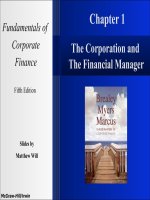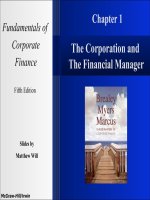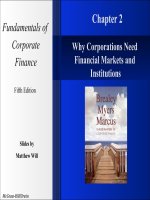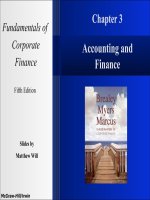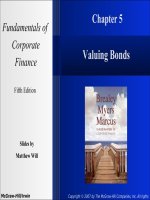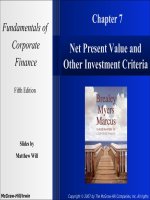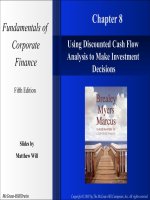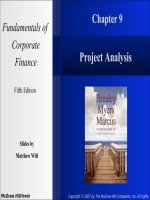Solution fundamentals of corporate finance brealy 4th chapter text solutions ch 11
Bạn đang xem bản rút gọn của tài liệu. Xem và tải ngay bản đầy đủ của tài liệu tại đây (85.81 KB, 14 trang )
Solutions to Chapter 11
Risk, Return, and Capital Budgeting
1.
a.
False. Investors require higher expected rates of return on investments with
high market risk, not high total risk. Variability of returns is a measure of
total risk. Stocks with high total risk (highly variable returns) can have low
market risk. That is, their returns have low correlation with the market.
b.
False. If beta = 0, the asset’s expected return should equal the risk-free rate,
not zero.
c.
False. The portfolio is one-third invested in Treasury bills and two-thirds in
the market. Its beta will be
1/3 × 0 + 2/3 × 1.0 = 2/3.
d.
True. High exposure to macroeconomic changes cannot be diversified away
in a portfolio. Thus stocks with higher sensitivity to macroeconomic risks
have higher market risk and higher expected returns when compared to
stocks with lower sensitivity to macroeconomic changes.
e.
True. For similar reasons as in (d). Sensitivity to fluctuations in the stock
market cannot be diversified away. Such stocks have higher systematic risk
and higher expected rates of return.
2.
The risks of deaths of individual policyholders are largely independent, and
therefore are diversifiable. Therefore, the insurance company is satisfied to charge
a premium that reflects actuarial probabilities of death, without an additional risk
premium. In contrast, flood damage is not independent across policyholders. If my
coastal home floods in a storm, there is a greater chance that my neighbor's will
too. Because flood risk is not diversifiable, the insurance company may not be
satisfied to charge a premium that reflects only the expected value of payouts.
3.
The actual returns on the Snake Oil fund exhibit considerable variation around the
regression line. This indicates that the fund is subject to diversifiable risk: it is not
well diversified. The variation in the fund's returns is influenced by more than just
market-wide events.
4.
Investors would buy shares of firms with high degrees of diversifiable risk, and
earn high risk premiums. But by holding these shares in diversified portfolios, they
would not necessarily bear a high degree of portfolio risk. This would represent a
profit opportunity, however. As investors seek these shares, we would expect their
11-1
Copyright © 2006 McGraw-Hill Ryerson Limited
prices to rise, and the expected rate of return to investors buying at these higher
prices to fall. This process would continue until the reward for bearing
diversifiable risk dissipated.
5.
a.
Required return = rf + β(rm – rf) = 4% + .6 (11% – 4%) = 8.2%
With an IRR of 14%, the project is attractive.
b.
If beta = 1.6, required return increases to:
4% + 1.6 (11% – 4%) = 15.2%
which is greater than the project IRR. You should now reject the project.
6.
c.
Given its IRR, the project is attractive when its risk and therefore its required
return are low. At a higher risk level, the IRR is no longer higher than the
expected return on comparable risk assets available elsewhere in the capital
market.
a.
The expected cash flows from the firm are in the form of a perpetuity. The
discount rate is:
rf + β(rm – rf) = 5% + .4(11% – 5%) = 7.4%.
Therefore, the value of the firm would be:
P0 = = = $135,135
b.
If the true beta is actually .6, the discount rate should be:
rf + β(rm – rf) = 5 + .6(11 – 5) = 8.6%
Therefore, the value of the firm is:
P0 = = = $116,279
By underestimating beta, you would overvalue the firm by
$135,135 – $116,279 = $18,856
11-2
Copyright © 2006 McGraw-Hill Ryerson Limited
7.
Required return = rf + β(rm – rf) = 4% + 1.25(11% – 4%) = 12.75%
Expected return = 11%
The stock’s expected return is less than the required return given its risk. Thus the
stock is overpriced. Why? Given the stock’s future cash flows and its current
price, investors can expect to earn only 11%. Comparable risk investments earn
12.75%. At the current price, investors are better off investing in these other
investments. This lack of demand will cause the stock price to fall until its
expected return increases to the required return of 12.75%.
8.
Required return = riskfree rate + beta × [ expected return on market – riskfree rate]
= rf + β(rm – rf)
For the stock, we know that 12% = rf + .8 ( 14% - rf )
Using the CAPM, solve for the riskfree rate of interest:
rf = (Required return - β rm) / ( 1 - β) = (12% - .8 × 14%) / (1 - .8) = 4%
We assume that the riskfree rate is not changed. Therefore, if the market return
turns out to be 10%, we expect that the stock’s return will be 4% + .8(10% - 4%) =
8.8%.
9.
a.
A diversified investor will find the highest-beta stock most risky. This is
Nike, which has a beta of 1.20.
b.
Nike has the highest total volatility; the standard deviation of its returns is
31%.
c.
β = (.61 + .53 + 1.20)/3 = .78
d.
The portfolio will have the same beta as Exxon, .61. The total risk of the
portfolio will be .61 times the total risk of the market portfolio because the
effect of firm-specific risk will be diversified away. The standard deviation
of the portfolio is therefore .61 × 20% = 12.2%.
e.
Using the CAPM, we compute the expected rate of return on each stock from
the equation r = rf + β × (rm – rf). In this case, rf = 4% and (rm – rf) = 7%.
Exxon:
r = 4% + .61(7%) = 8.27%
Polaroid: r = 4% + .53(7%) = 7.71%
Nike:
r = 4% + 1.20(7%) = 12.4%
11-3
Copyright © 2006 McGraw-Hill Ryerson Limited
10.
The following table shows the average return on Tumblehome for various values
of the market return. It is clear from the table that, when the market return
increases by 1%, Tumblehome’s return increases on average by 1.5%. Therefore, β
= 1.5. If you prepare a plot of the return on Tumblehome as a function of the
market return, you will find that the slope of the line through the points is 1.5.
Market return(%)
−2
−1
0
1
2
Average return on Tumblehome(%)
−3.0
−1.5
0.0
1.5
3.0
Note: If your calculator supports statistics then you can estimate this. Enter points
as X,Y values. In stats linear mode you see that b = 1.5 which is the slope of the
line. Using the SLOPE function in Excel will also calculate the slope of 1.5.
11.
a.
Beta is the responsiveness of each stock's return to changes in the market
return. Then:
βA = = = = 1.2
βD = = = = .75
D is considered to be a more defensive stock than A because its return is less
sensitive to the return of the overall market. In a recession, D will usually
outperform both stock A and the market portfolio.
b.
We take an average of returns in each scenario to obtain the expected return.
rm = (32% – 8%)/2 = 12%
rA = (38%– 10%)/2 = 14%
rD = (24% – 6%)/2 = 9%
11-4
Copyright © 2006 McGraw-Hill Ryerson Limited
c.
According to the CAPM, the expected returns that investors will demand of
each stock, given the stock betas and given the expected return on the
market, are:
r = rf + β(rm – rf)
rA = 4% + 1.2(12% – 4%) = 13.6%
rD = 4% + .75(12% – 4%) = 10.0%
d.
12.
The return you actually expect for stock A, 14%, is above the fair return,
13.6%. The return you expect for stock D, 9%, is below the fair return, 10%.
Therefore stock A is the better buy.
Figure follows below.
Cost of capital = risk-free rate + beta × market risk premium
Since the risk-free rate is 4% and the market risk premium is 7%, we can write the
cost of capital as:
Cost of capital = 4% + beta × 7%
Cost of capital (from CAPM)
= 10% + beta × 8%
4% + .75 × 7% = 9.25%
4% + 1.75 × 7% = 16.25%
Beta
.75
1.75
r
SML
11%
7% = market risk
premium
4%
beta
0
1.0
The cost of capital of each project is calculated using the above CAPM formula.
Thus, for Project P, its cost of capital is: 4% + 1.0 × 7% = 11%.
11-5
Copyright © 2006 McGraw-Hill Ryerson Limited
If the cost of capital is greater than IRR, then the NPV is negative. If the cost of
capital equals the IRR, then the NPV is zero. Otherwise, if the cost of capital is
less than the IRR, the NPV is positive.
Project
P
Q
R
S
T
13.
Beta
1.0
0.0
2.0
0.4
1.6
Cost of capital
11.0%
4.0
18.0
6.8
15.2
IRR
11%
6
17
7
16
NPV
0
+
−
+
+
The appropriate discount rate for the project is:
r = rf + β(rm – rf) = 4% + 1.4(11% – 4%) = 13.8%
Therefore:
NPV = –100 + 15 × annuity factor(13.8%, 10 years) = –100 + 78.8563 = -$21.14
You should reject the project.
14.
We need to find the discount rate for which:
15 × annuity factor(r, 10 years) = 100.
Solving this equation on the calculator, we find that the project IRR is 8.14%. The
IRR is less than the opportunity cost of capital, 13.8%. Therefore you should
reject the project, just as you found from the NPV rule.
15.
From the CAPM, the appropriate discount rate is:
r = rf + β(rm – rf) = 4% +.75(7%) = 9.25%
r = .0925 = =
P1 = $52.625
11-6
Copyright © 2006 McGraw-Hill Ryerson Limited
16.
If investors believe the year-end stock price will be $54, then the expected return
on the stock is:
= .12 = 12%,
which is greater than the opportunity cost of capital. Alternatively, the “fair” price
of the stock (that is, the present value of the investor's expected cash flows) is
(2 + 54)/1.0925 = $51.26, which is greater than the current price. Investors will
want to buy the stock, in the process bidding up its price until it reaches $51.26.
At that point, the expected return is a “fair” 9.25%:
= .0925 = 9.25%.
17.
a.
The expected return of the portfolio is the weighted average of the returns on
the TSX and T-bills. Similarly, the beta of the portfolio is a weighted average
of the beta of the TSX (which is 1.0) and the beta of T-bills (which is zero).
(i)
(ii)
(iii)
(iv)
(v)
18.
E(r) = 0 × 13% + 1.0 × 5% = 5%
E(r) = .25 × 13% + .75 × 5% = 7%
E(r) = .50 × 13% + .50 × 5% = 9%
E(r) = .75 × 13% + .25 × 5% = 11%
E(r) = 1.00 × 13% + 0 × 5% = 13%
β= 0×1 + 1×0 = 0
β = .25 × 1 + .75 × 0 = .25
β = .50 × 1 + .50 × 0 = .50
β = .75 × 1 + .25 × 0 = .75
β = 1.0 × 1 + 0 × 0 = 1.0
b.
For every increase of .25 in the β of the portfolio, the expected return
increases by 2%. The slope of the relationship (additional return per unit of
additional risk) is therefore 2%/.25 = 8%.
c.
The slope of the return per unit of risk relationship is the market risk
premium:
rM – rf = 13% – 5% = 8%, which is exactly what the SML predicts. The SML
says that the risk premium equals beta times the market risk premium.
a.
Call the weight in the TSX w and the weight in T-bills (1 – w). Then w must
satisfy the equation:
w × 10% + (1 – w) × 5% = 8%
which implies that w = .6. The portfolio would be 60% in the TSX and 40%
in T-bills. The beta of the portfolio would be the weighted average of the
betas of the TSX and T-Bills. Since T-Bills are risk-free, their beta is zero.
The beta of the portfolio is: .6×1 + .4×0 = .6
11-7
Copyright © 2006 McGraw-Hill Ryerson Limited
b.
To form a portfolio with a beta of .4, use a weight of .40 in the TSX and a
weight of .60 in T-bills. Then, the portfolio beta would be:
β = .40 × 1 + .60 × 0 = .40
The expected return on this portfolio is .4 × 10% + .6 × 5% = 7%
c.
Both portfolios have the same ratio of risk premium to beta:
= = 5%.
Notice that the ratio of risk premium to risk (i.e., beta) equals the market risk
premium (5%) for both stocks.
19.
If the systematic risk were comparable to that of the market, the discount rate
would be 12.5%. The property would be worth $50,000/.125 = $400,000.
20.
The CAPM states that r = rf + β(rm – rf). If β < 0, then r < rf. Investors would
invest in a security with an expected return below the risk-free rate because of the
hedging value such a security provides for the rest of the portfolio. Investors get
their “reward” in terms of risk reduction rather than in the form of high expected
return.
21.
The historical risk premium on the market portfolio has been about 7%. Therefore,
using this value and the assumed risk-free rate of 4%, we can use the CAPM to
derive the cost of capital for these firms as 4% + β × 7%.
ATI Technologies
Nova Chemicals
Quebecor World
Shaw Communications
22.
Beta
2.48
.95
.41
.9
Cost of capital
21.36%
10.65
6.87
10.3
r = rf + β(rm – rf)
5 = rf + .5(rm – rf)
(stock A)
13 = rf + 1.5(rm – rf)
(stock B)
Solve these simultaneous equations to find that r f = 1% and rm = 9%. Thus the
market risk premium is 9% - 1%, or 8%.
11-8
Copyright © 2006 McGraw-Hill Ryerson Limited
23.
r = rf + β(rm – rf)
10 = 6 + β(14 – 6)
β = .5
24.
Internet: Applying the CAPM
Tips: If your school's library subscribes to Financial Post Advisor, students have
access to betas for Canadian stocks. They are found in FP Analyzer, in the Spot
Data section. Betas can also be collected at a Bloomberg terminal, if your
students have access to one.
An interesting extension is to ask students to estimate their own betas. However,
getting stock returns and market index returns is more work. If your school has
access to the CFMRC database, it is an easy task to get rates of return. To put
together rates of return using internet resources is more challenging. Historical
stock prices and index levels can be downloaded from ca.finance.yahoo.ca.
Ideally, dividends and the ex-dividend dates would be matched to the stock
prices before rates of return are calculated. (Most beta services, including
Bloomberg, calculate betas without including dividends in the stock returns
because it is much more work to match up the dividends with stock prices). If
you want students to estimate their own betas, the Slope function in Excel
produces an estimate.
Expected results: This exercise is self-explanatory.
25.
Shaw Communications should use the beta of ATI Technologies (which is 2.48) to
find that the required rate of return is 21.36%. The project is an investment in
graphics hardware and the beta of ATI reflects the risk of a firm in the graphics
hardware business. The beta of Shaw Communications reflects the risk of a cable
and satellite communications company.
26.
a.
False. The stock’s risk premium, not its expected rate of return, is twice as
high as the market’s.
b.
True. The stock’s unique risk does not affect its contribution to portfolio risk
but its market risk does.
c.
False. A stock plotting below the SML offers too low an expected return
relative to the expected return indicated by the CAPM. The stock is
overpriced. Investors will not want to pay that price to receive the stock’s
cash flows. The price must fall to increase the stock’s rate of return.
11-9
Copyright © 2006 McGraw-Hill Ryerson Limited
27.
d.
True. If the portfolio is diversified to such an extent that it has negligible
unique risk, then the only source of volatility is its market exposure. A beta
of 2 then implies twice the volatility of the market portfolio.
e.
False. An undiversified portfolio has more than twice the volatility of the
market. In addition to the fact that it has double the sensitivity to market risk,
it also has volatility due to unique risk.
The CAPM implies that the expected rate of return that investors will demand of
the portfolio is:
r = rf + β(rm – rf) = 4% + .8(11% – 4%) = 9.6%
If the portfolio is expected to provide only a 9% rate of return, it’s an unattractive
investment. The portfolio does not provide an expected return that is sufficiently
high relative to its risk.
28.
A portfolio invested 80% in a stock market index fund (with a beta of 1.0) and
20% in a money market fund (with a beta of zero) would have the same beta as
this manager's portfolio:
β = .80 × 1.0 + .20 × 0 = .80
However, it would provide an expected return of
.80 × 11% + .20 × 4% = 9.6%
which is better than the portfolio manager's expected return.
29.
The security market line provides a benchmark expected return that an investor
can earn by mixing index funds with money market funds. Before you place your
funds with a professional manager, you will need to be convinced that he or she
can earn an expected return (net of fees) in excess of the expected return available
on an equally risky index fund strategy.
30.
a.
r = rf + β(rm − rf) = 5% + [–.2 × (12% – 5%)] = 3.6%
b.Portfolio beta = .90 × βmarket + .10 × βlaw firm
= .90 × 1.0 + .10 × (−.2) = .88
31.
Expected income on stock fund: $2 million × .12
Interest paid on borrowed funds: $1 million × .04
Net expected earnings:
11-10
Copyright © 2006 McGraw-Hill Ryerson Limited
= .24 million
= .04 million
$0.20 million
Expected rate of return on the $1 million you invest is:
= .20 = 20%
Risk premium = 20% – 4% = 16%
This is double the risk premium of the market index fund (which is 8%, = 12% - 4%)
The risk is also double that of holding a market index fund. You have $2 million at
risk, but the net value of your portfolio is only $1 million. A 1% change in the rate
of return on the market index will change your profits by .01 × $2 million = $20,000.
But this changes the rate of return on your portfolio by $20,000/$1,000,000 = 2%,
double that of the market. So your risk is in fact double that of the market index.
32.
a.
Expected rate of return = rf + β(rm − rf)
= .04 + .9 × (.11 - .04) = .103 = 10.3%
b.
The appropriate discount rate to evaluate ChemCo is one that reflects the
riskiness of ChemCo’s cash flows. Since we know that ChemCo's current
beta is 1.4, it is reasonable to use this in the calculation of the appropriate
discount rate. Note that the discount rate of BigCo is irrelevant because
BigCo has three different divisions, of which only one is in the same business
of ChemCo.
Discount rate = rf + β(rm − rf) = .04 + 1.4 × (.11 - .04) = .138 = 13.8%
c.
Assuming that these are after-tax cash flows and using the constant dividend
growth model, the value of ChemCo is
Value of ChemCo = = $91.837 million
d.
Think of BigCo as a portfolio consisting of the original three divisions plus
the new ChemCo division. Thus, the new beta of BigCo will equal the
weighted average of its old beta and the beta ChemCo, with the weights
based on the market values of three original divisions, ChemCo and the new
combined BigCo. The value of BigCo is its original $1,000 million plus the
value of ChemCo, for a total of $1,091.837 million.
Weight for ChemCo division = =
= .084 = 8.4%
Weight for original BigCo = =
= .916 = 91.6%
New beta of BigCo = .084 × 1.4 + .916 × .9 = .942
As expected, adding ChemCo, with its higher beta, causes the beta of BigCo
11-11
Copyright © 2006 McGraw-Hill Ryerson Limited
to increase.
33.
a.
We take advantage of the formula for the present value of a growing
[ () ]
annuity, found in Chapter 4: × 1 - T for valuing the Year 2 to 5 cash
flows and recognize that starting in Year 6, each stock has a constant
perpetual growth rate and can be valued using the constant dividend
growth model, DIV/(r – g).
Food Express (FE)
Required rate of return = rf + β(rm − rf) = .04 + .85 × (.10 - .04) = .091
Value of FE today:
[ () ] + ×
4
= +× × 1-
= $114.754 million
Computer Power (CP)
Required rate of return = rf + β(rm − rf) = .04 + .95 × (.10 - .04) = .097
Value of CP today:
[ () ]
=+×× 1-
4
+×
= $40.09 million
Bridge Steel (BS)
Required rate of return = rf + β(rm − rf) = .04 + 1.3 × (.10 - .04) = .118
Value of BS today:
[ () ]
=+× × 1-
4
+×
= $110.07 million
b.
Total portfolio value = $114.754 + $40.09 + $110.07 = $264.914 million
β
Weight × β
Company
FE
Weight in Portfolio
= .4332
.85
.3682
CP
= .1513
.95
.1437
11-12
Copyright © 2006 McGraw-Hill Ryerson Limited
BS
= .4155
1.3
.5402
Total
1.0521
The portfolio beta is the weighted average of the individual stocks’ betas and
is about 1.1.
34.
a.
This question is most easily handled with a spreadsheet but can be done
using the formulas.
State of the
Economy
Recession
Normal
Boom
Probability Division Division Division Division
A
B
C
D
0.2
8%
-10%
-1%
-4%
0.6
8%
15%
7%
15%
0.2
9%
30%
10%
20%
Expected return
Standard
deviation
Firm
Market
-1.75%
11.25%
17.25%
-3%
11%
22%
8.2%
13.0%
6.0%
12.2%
9.9%
10.4%
0.40%
12.88%
3.69%
8.33%
6.25%
7.94%
b. Using the formula βj = , where corrjm is the correlation between stock j’s return
and the market return, σj is the standard deviation of stock j’s return and σ m is
the standard deviation of the market return:
βmarket = = = 1
βA = = = .0368
βB = = = 1.61
βC = = = .451
βD = = = .991
Since each of the four divisions is worth about ¼ of the firm’s market value,
the beta of the firm is the equal-weighted average of the four divisions’ betas:
βFirm = = (.0368 + 1.61 + .451 + .991)/4 = .77
c. According to the CAPM, the required rate of return is
rj = rf + βj (rm − rf)
Assuming the riskfree rate is 4 percent, and using the expected return on the
market calculated in (a), the required rate of return to each division is:
rA = .04 + .0368 × (.104 - .04) = .0424 = 4.24%
rB = .04 + 1.61 × (.104 - .04) = .143 = 14.3%
11-13
Copyright © 2006 McGraw-Hill Ryerson Limited
rC = .04 + .451 × (.104 - .04) = .0689 = 6.89%
rD = .04 + .991 × (.104 - .04) = .103 = 10.3%
d. Compare each division’s expected return, calculated in (a), with its required
return, calculated according to the CAPM and reported in (c). Divisions with
expected return at least equal to or greater than the required return are
generating positive NPV. Those whose expected return is less than the required
return are underperforming and provide negative NPV. Conglomerate should a
buyer who can improve the performance of these negative NPV divisions.
Hopefully, Conglomerate will sell these poorly performing divisions for more
than they are worth under its control, capturing some of gains from the
improved performance (See Chapter 23 for more on how companies share
gains from mergers).
Both Divisions A and D have expected returns greater than the CAPM required
rate of return. However, Division B, with a required rate of return of 14.3%,
has an expected return of 13%. Likewise, Division C has a required rate of
return of 6.89% but its expected rate of return is 6%. This means Divisions B
and C are likely candidates for sale. However, Conglomerate may want to
consider whether improvements in performance can be made to increase the
expected rates of return, without resorting to selling the divisions.
35.
Standard & Poor's
Expected results: This will give students hands-on experience with beta
estimations.
36.
Standard & Poor's
Expected results: Use Market Insight to provide beta estimates. Student
hopefully will be able to see patterns in the betas that relate business activities of
the
companies. Encourage the students to learn more about each company's main
businesses and think about how market-wide factors affect their revenues and
costs.
11-14
Copyright © 2006 McGraw-Hill Ryerson Limited
